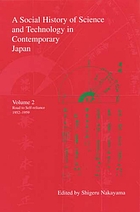Yoshioka, Hitoshi, “Forming a Nuclear Regime and Introducing Commercial Reactors,” and “Nuclear Power Research and the Scientists’ Role”; and Sasamoto, Yukuo, “The Bikini Incident and Radiation Surveys,” in A Social History of Science and Technology in Contemporary Japan: Road to Self-reliance, 1952-1959, edited by Shigeru Nakayama, Kunio Gotō, and Hitoshi Yoshioka (Trans Pacific Press, 2005), 80-143.

A Social History of Science and Technology in Contemporary Japan, Volume 2 is an edited volume that offers three chapters specifically related to nuclear power, the first two written by Hitoshi Yoshioka and the third by Yukuo Sasamoto. The first, “Forming a Nuclear Regime and Introducing Commercial Reactors,” offers a useful chronicling of most every important legal and administrative development of Japan’s nuclear power policy during the 1950s. Eventually, Yoshioka diverges from the minutiae of governance to offer a rather insightful analysis of the debates and rivalries that dominated the era, particularly domestic development of technology versus its importation, as well as the role of the public versus private funds in the development of the industry. This chapter heavily details the development of nuclear policy and most of the analysis is focused on the bureaucratic turf battles between the Ministry of Industry and International Trade and the Science and Technology Agency.
The second nuclear power chapter is “Nuclear Power Research and the Scientists’ Role,” which describes the how scientists, primarily physicists, affected or failed to affect the development of Japanese nuclear policy. He details how scientists attempted to control and shape nuclear policy, such as outlining the three principles for nuclear development (i.e., independent, transparent, and democratic development of peaceful uses of nuclear power). These principles, however, Yoshioka argues, were an attempt to play a role in nuclear policy rather than actual guiding principles of the development of nuclear power. Furthermore, he shows how politicians managed to outmaneuver scientists by adopting their ideas and recruited them to government positions when it suited them and ignoring those who deviated from the official line. Yoshioka illustrates the academic split between nuclear physicists and engineers, in part blaming it for a divided academic approach to nuclear policy.
Chapter 5, “The Bikini Incident and Radiation Surveys, by Yukuo Sasamoto discusses the Daigo Fukuryuu Maru Incident (also known as the Lucky Dragon Incident or the Bikini Incident), in which a Japanese fishing vessel was caught in the fallout of an American hydrogen bomb test, resulting in the 23 crew members coming down with acute radiation sickness. The incident occurred just as the Japanese were about to begin research into nuclear power. This chapter discusses the medical treatment of the crew, the broader issue of radioactive fallout’s effects on Japan, the precautions taken regarded contaminated of fishing vessels and crops. Sasamoto argues that the Japanese government used the Bikini Incident as an opportunity to investigate the effects of radioactivity on humans and to gain information on nuclear physics from the Americans. By design, the focus remains squarely on the medical issues and the government agencies that were responsible for investigating the damaging effects of nuclear weapons testing, and only notes, but does not examine, the broad effects the incident had on Japanese society.
This volume contains a number of other chapters that, though they are not directly about nuclear power, may prove interesting to readers who want a more complete understanding of Japanese energy policy. Of particular note are chapter 20 “The Energy Revolution and Changing Energy Policies” by Kunio Gotou, chapter 21 “The Energy Revolution” by Munehiro Miwa, and chapter 22 “The Reconstruction of the Electric Power Industry” by Takuji Okamoto.
-Craig Nelson
![[Teach311 + COVID-19] Collective](https://blogs.ntu.edu.sg/teach311/files/2020/04/Banner.jpg)
Pingback: BOOK: A Social History of Science and Technology in Contemporary Japan: Volume 4: Transformation Period, 1970-1979 | Teach 3.11